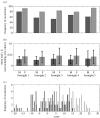Individual and gender fingerprints in human body odour
- PMID: 17251141
- PMCID: PMC2359862
- DOI: 10.1098/rsif.2006.0182
Individual and gender fingerprints in human body odour
Abstract
Individuals are thought to have their own distinctive scent, analogous to a signature or fingerprint. To test this idea, we collected axillary sweat, urine and saliva from 197 adults from a village in the Austrian Alps, taking five sweat samples per subject over 10 weeks using a novel skin sampling device. We analysed samples using stir bar sorptive extraction in connection with thermal desorption gas chromatograph-mass spectrometry (GC-MS), and then we statistically analysed the chromatographic profiles using pattern recognition techniques. We found more volatile compounds in axillary sweat than in urine or saliva, and among these we found 373 peaks that were consistent over time (detected in four out of five samples per individual). Among these candidate compounds, we found individually distinct and reproducible GC-MS fingerprints, a reproducible difference between the sexes, and we identified the chemical structures of 44 individual and 12 gender-specific volatile compounds. These individual compounds provide candidates for major histocompatibility complex and other genetically determined odours. This is the first study on human axillary odour to sample a large number of subjects, and our findings are relevant to understanding the chemical nature of human odour, and efforts to design electronic sensors (e-nose) for biometric fingerprinting and disease diagnoses.
Figures



References
-
- Ackerl K, Atzmüller A, Grammer K. The scent of fear. Neuroendocrinol. Lett. 2001;23:79–84. - PubMed
-
- Albone E.S, Gosden P.E, Ware G.C. Bacteria as a source of chemical signals in mammals. In: Müller-Schwarze D, Mozell M.M, editors. Chemical signals in vertebrates. Plenum Press; New York, NY: 1977. p. 35.
-
- Asano K.G, Bayne C.K, Horsman K.M, Buchanan M.V. Chemical composition of fingerprints for gender determination. J. Forensic Sci. 2002;47:805–807. - PubMed
Publication types
MeSH terms
Substances
LinkOut - more resources
Full Text Sources
Other Literature Sources
Medical
Molecular Biology Databases
Miscellaneous

